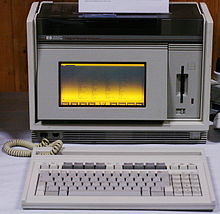HP Integral PC
The HP Integral PC (or HP 9807A ) was a mobile UNIX - workstation used by Hewlett-Packard was produced. The system was introduced in 1985. It was based on a Motorola 68000 microprocessor clocked at 8 MHz. The system had an early version of the HP-UX operating system installed in ROM.
hardware
The Integral PC was operated exclusively on the network, so it belonged to the portable category . It was equipped with an orange 9 inch electroluminescent screen with a resolution of 512 × 255 pixels or 80 × 28 characters. In addition, a 710 kB 3.5 "floppy disk drive and an 80-character HP ThinkJet inkjet printer, which was state-of-the-art for the time, were built in. The standard storage capacity was 256 kB ROM plus 512 kB RAM, expandable to 1.5 MB. An HP-IB -Interface was also available. In addition, there was the possibility of installing expansion modules. The mechanical design was based on the actual industry standard HP 85, expanded with a modern processor.
The concept of an upright computer with attached keyboard and integrated printer as well as mass storage devices was still used up to the current millennium, i. H. Followed up by various providers 20 years later. The entire system could be folded up, making it very robust and easy to transport (apart from its weight of approximately 10 kg).
In the Integral PC, CPU, RAM, ROM, memory management, I / O buffering, system timing and keyboard interface were integrated on a logic board. All peripheral units and the 14 connections were implemented with independent boards. Each of these boards was a bit smaller than an A4 page. Each board had its own timer for an easier function test. The I / O board with two connections for optional plug-in cards, the keyboard interface, the "Human Interface Link" (HP-HIL) and the power supply could be checked and serviced independently.
The graphics processor of the Integral PC (GPU) was a special processor, developed with the ability to control an electroluminescent display or almost any monitor. This processor provided an easy-to-use graphic subsystem with which bit-mapped displays can be controlled very easily. The GPU could write lines, rectangles and alphanumeric characters on the screen in hardware. It also provided a graphic cursor and a display RAM interface.
The electroluminescent display was based on a thin-film technology that was developed at the time by several companies in cooperation with HP.
software
The Integral PC was so unusual in that it already brought the HP-UX operating system with it in ROM. The operating system also contained the HP Windows graphical user interface ( GUI ) and a Personal Applications Manager (PAM). Further HP-UX commands and auxiliary programs were supplied on separate floppy disks.
Optionally, the system could also be equipped with a complete HP-BASIC in the ROM, so it was immediately ready for writing and executing BASIC programs after switching on.
Historical background
The HP Integral PC was developed as the successor to the HP 80 series , but with the same size as the HP BASIC 9000 series. The idea was to provide a portable, yet powerful computer system for engineers that combines all components in a portable unit. The integral PC was not accepted by the market, however, because on the one hand a price of around 15,000 DM was seen as clearly too high and on the other hand there was no BASIC compatibility either with the 80 series (not at all) or with the 9000 series (incomplete) .
credentials
- HP Introduces Unix Portable, Kathy Chin InfoWorld, January 21, 1985 viewed on May 17, 2016
- HP Integral PC specifications as of March 18, 1985 viewed May 17, 2016

